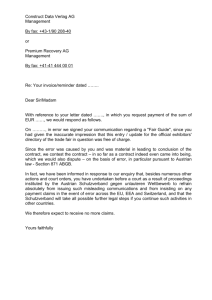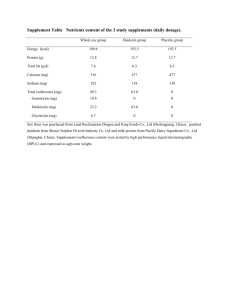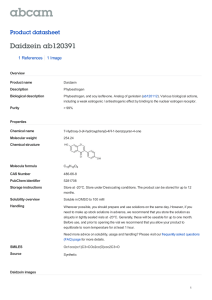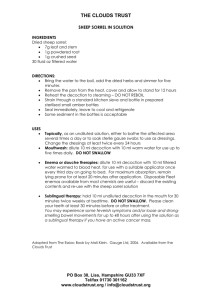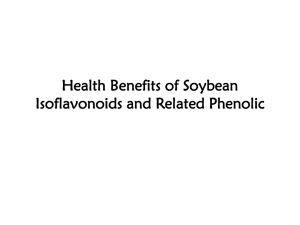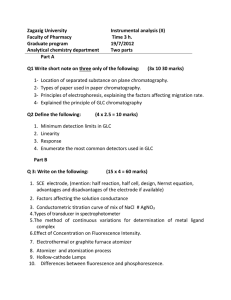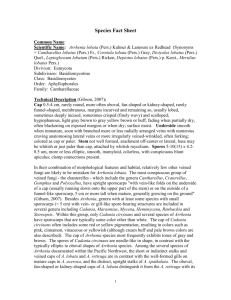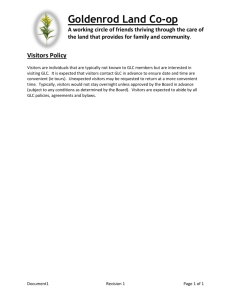Advance Journal of Food Science and Technology 7(3): 173-176, 2015
advertisement
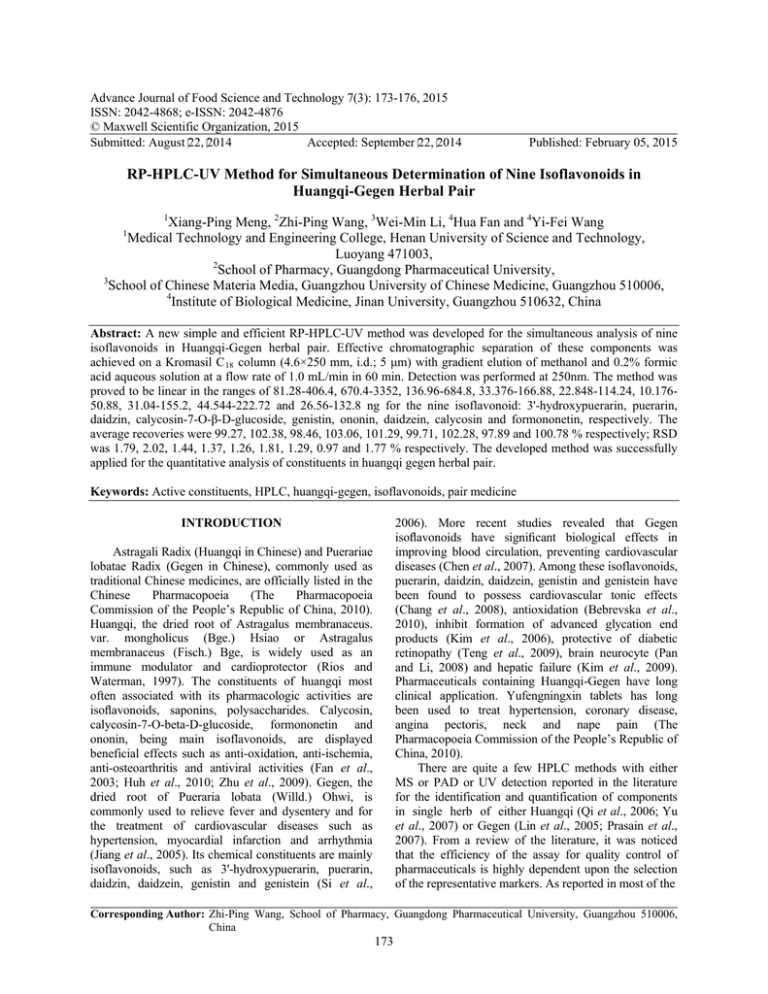
Advance Journal of Food Science and Technology 7(3): 173-176, 2015 ISSN: 2042-4868; e-ISSN: 2042-4876 © Maxwell Scientific Organization, 2015 Submitted: August 22, 2014 Accepted: September 22, 2014 Published: February 05, 2015 RP-HPLC-UV Method for Simultaneous Determination of Nine Isoflavonoids in Huangqi-Gegen Herbal Pair 1 Xiang-Ping Meng, 2Zhi-Ping Wang, 3Wei-Min Li, 4Hua Fan and 4Yi-Fei Wang 1 Medical Technology and Engineering College, Henan University of Science and Technology, Luoyang 471003, 2 School of Pharmacy, Guangdong Pharmaceutical University, 3 School of Chinese Materia Media, Guangzhou University of Chinese Medicine, Guangzhou 510006, 4 Institute of Biological Medicine, Jinan University, Guangzhou 510632, China Abstract: A new simple and efficient RP-HPLC-UV method was developed for the simultaneous analysis of nine isoflavonoids in Huangqi-Gegen herbal pair. Effective chromatographic separation of these components was achieved on a Kromasil C 18 column (4.6×250 mm, i.d.; 5 μm) with gradient elution of methanol and 0.2% formic acid aqueous solution at a flow rate of 1.0 mL/min in 60 min. Detection was performed at 250nm. The method was proved to be linear in the ranges of 81.28-406.4, 670.4-3352, 136.96-684.8, 33.376-166.88, 22.848-114.24, 10.17650.88, 31.04-155.2, 44.544-222.72 and 26.56-132.8 ng for the nine isoflavonoid: 3'-hydroxypuerarin, puerarin, daidzin, calycosin-7-O-β-D-glucoside, genistin, ononin, daidzein, calycosin and formononetin, respectively. The average recoveries were 99.27, 102.38, 98.46, 103.06, 101.29, 99.71, 102.28, 97.89 and 100.78 % respectively; RSD was 1.79, 2.02, 1.44, 1.37, 1.26, 1.81, 1.29, 0.97 and 1.77 % respectively. The developed method was successfully applied for the quantitative analysis of constituents in huangqi gegen herbal pair. Keywords: Active constituents, HPLC, huangqi-gegen, isoflavonoids, pair medicine 2006). More recent studies revealed that Gegen isoflavonoids have significant biological effects in improving blood circulation, preventing cardiovascular diseases (Chen et al., 2007). Among these isoflavonoids, puerarin, daidzin, daidzein, genistin and genistein have been found to possess cardiovascular tonic effects (Chang et al., 2008), antioxidation (Bebrevska et al., 2010), inhibit formation of advanced glycation end products (Kim et al., 2006), protective of diabetic retinopathy (Teng et al., 2009), brain neurocyte (Pan and Li, 2008) and hepatic failure (Kim et al., 2009). Pharmaceuticals containing Huangqi-Gegen have long clinical application. Yufengningxin tablets has long been used to treat hypertension, coronary disease, angina pectoris, neck and nape pain (The Pharmacopoeia Commission of the People’s Republic of China, 2010). There are quite a few HPLC methods with either MS or PAD or UV detection reported in the literature for the identification and quantification of components in single herb of either Huangqi (Qi et al., 2006; Yu et al., 2007) or Gegen (Lin et al., 2005; Prasain et al., 2007). From a review of the literature, it was noticed that the efficiency of the assay for quality control of pharmaceuticals is highly dependent upon the selection of the representative markers. As reported in most of the INTRODUCTION Astragali Radix (Huangqi in Chinese) and Puerariae lobatae Radix (Gegen in Chinese), commonly used as traditional Chinese medicines, are officially listed in the Chinese Pharmacopoeia (The Pharmacopoeia Commission of the People’s Republic of China, 2010). Huangqi, the dried root of Astragalus membranaceus. var. mongholicus (Bge.) Hsiao or Astragalus membranaceus (Fisch.) Bge, is widely used as an immune modulator and cardioprotector (Rios and Waterman, 1997). The constituents of huangqi most often associated with its pharmacologic activities are isoflavonoids, saponins, polysaccharides. Calycosin, calycosin-7-O-beta-D-glucoside, formononetin and ononin, being main isoflavonoids, are displayed beneficial effects such as anti-oxidation, anti-ischemia, anti-osteoarthritis and antiviral activities (Fan et al., 2003; Huh et al., 2010; Zhu et al., 2009). Gegen, the dried root of Pueraria lobata (Willd.) Ohwi, is commonly used to relieve fever and dysentery and for the treatment of cardiovascular diseases such as hypertension, myocardial infarction and arrhythmia (Jiang et al., 2005). Its chemical constituents are mainly isoflavonoids, such as 3'-hydroxypuerarin, puerarin, daidzin, daidzein, genistin and genistein (Si et al., Corresponding Author: Zhi-Ping Wang, School of Pharmacy, Guangdong Pharmaceutical University, Guangzhou 510006, China 173 Adv. J. Food Sci. Technol., 7(3): 173-176, 2015 Table 1: Structure of nine isoflavones in Huangqi-Gegen herbal pair No 1 2 3 4 5 6 7 8 9 -------------------------------------------------------------------------------------------------------------------------------------------------------Components R1 R2 R3 R4 R5 3'-Hydroxyl puerarin H H Glc OH H Puerarin H H Glc H H Daidzein H Glc H H H Calycosin glycosides H Glc H OH Me Genistin OH Glc H H H Ononin H Glc H H Me Daidzein H H H H H Calycosin H H H OH Me Formononetin H H H H Me Table 2: The mobile phase gradient elution procedure Time/min Mobile phase A/% Mobile phase B/% 0 ~ 15 25 75 15 ~ 30 25→45 75→55 30 ~ 45 45 55 45 ~ 50 45→25 55→75 50 ~ 60 25 75 literature for Huangqi and Gegen, it was readily established that calycosin-7-O-beta-D-glucoside is present in the highest quantity in Huangqi (Wu et al., 2005), whilst daidzin is also found in a large quantities in Gegen. Therefore, the above reported assay, which did not include these active components, could not serve as a sufficient quality control tool for pharmaceuticals containing both Huangqi and Gegen. A simple and efficient assay method capable of detecting multiple active components from both herbs is essential. For an objective and scientific assessment of the quality of Huangqi-Gegen decoction and other Chinese medicines containing Huangqi-Gegen pair medicines, this study established a method for the determination of nine isoflavonoids by RP-HPLC-UV. substance, in methanol in a 25 mL volumetric flask and mix well. Measure accurately this stock solution, dilute with mobile phase at initial proportion, the concentration of the working solution was 20.32, 167.60, 34.24, 8.34, 5.71, 6.54, 7.76, 11.14, 24.80 and 6.64 μg/mL (1-9), respectively. Test preparation: According to the proportion of Huangqi-Gegen decoction prescription, weighed 20 g of huangqi pieces, 10 g of gegen pieces, add 10 times of water, reflux extraction two times, each time for 1 h, the combined extracts were concentrated under reduced pressure and constant volume at 250 mL, shake and filtrate (0.45 μm). MATERIALS AND METHODS Materials: Shimadzu LC 10AT vp plus highperformance liquid chromatography, SHIMADZU SPD 10A vp plus UV detector, SHIMADZU CBM 10A vp plus ChemStation; Sartorius electronic balance (Germany, d 0.01 mg); polarimeter (WXG 4, Shanghai Pudong Physical Optics Instrument Factory); methanol HPLC grade water for the preparation of pure water, other reagents were of analytical grade; puerarin reference was purchased from the National Institutes for food and drug Control, genistin and other reference were from Shanghai Tauto biotech, calycosin-7-O-β-Dglucoside reference was provided by the Shanghai Chinese chemical reference substance Ltd., 3'-hydroxypuerarin and daidzein reference (Kim et al., 2009; Teng et al., 2009) by the laboratory-made (melting point, specific rotation, UV, MS and NMR is consistent with the literature, purity>96%), the structure of nine isoflavones in Table 1. Huangqi and Gegen herbs, purchased from Guangzhou University of Chinese Medicine Pharmacy Ltd., were identified by Professor weimin Li. Methodological studies: Limits of detection and quantification: The Limits of Detection (LOD) and Quantification (LOQ) for each studied component were defined as the lowest concentration of component in the diluted standard solution producing a signal-to-noise ratio (S/N) of 3:1 and 10:1, respectively. Preparation of the test solution: Reference preparation: Dissolve appropriate amount of reference Calibration curves: Working solutions containing all nine references were prepared by diluting the stock Chromatographic conditions and system suitability: Kromasil 100-5 C 18 (4.6 × 250 mm, id., 5 μm) column, pre-column (Security Guard, C 18 , 4.0×3.0 mm, Phenomenex); using methanol as mobile phase A, 0.1% citric acid solution as mobile phase B, gradient elution (Table 2); flow rate of 1.0 mL/min, column temperature was 25°C, the detection wavelength was 250 nm, the injection volume was 10 μL. Theoretical plates of the test solution chromatogram with each corresponding absorption peaks were not less than 7000 and peaks separation greater than 2.0. 174 Adv. J. Food Sci. Technol., 7(3): 173-176, 2015 Table 3: The linear relationship of isoflavones y = ax+b (y = Peak area, x = Injection Quality, ng) ------------------------------------------------------------------------No a b R2 1 3269.8 9273.800 1.0000 2 4846.4 -1490266 0.999 9 3 33740 -6075100 0.999 6 4 3088.2 -16236.70 1.0000 5 2966.4 -1417400 0.999 8 6 6478.9 -2749200 0.999 9 7 4327.2 -252.4200 0.999 9 8 2898.3 3075.1000 0.999 8 9 3548.2 1417.4000 0.999 9 Table 4: The linear relationship of isoflavones No The linear range/ng LOD/ng 1 81.28-406.4 19.24 2 670.4-3352 19.74 3 136.96-684.8 21.40 4 33.376-166.88 8.040 5 22.848-114.24 6.280 6 26.176-130.88 6.540 7 31.04-155.2 8.550 8 44.544-222.72 9.88 9 26.56-132.8 7.32 LOQ/ng 63.50 65.80 68.48 25.72 20.98 20.68 25.50 30.52 22.80 Fig. 1: Representative HPLC-UV (250 nm) chromatograms of: (A) refrence, (B) Sample. Peak number: (1): 3'hydroxypuerarin; (2): puerarin; (3): daidzin; (4): calycosin-glucoside; (5): genistin; (6): ononin; (7): daidzein; (8): calycosin; (9): formononetin solution to proper concentration in order to draw calibration curves. Each calibration curve contained six different concentrations and was performed in triplicate: Table 5: The linear relationship of isoflavones Different regions -----------------------------------------------------------------ShanxiNeimongShanxi-hunan guangdong hunan No 1 1.94±0.160 0.92±0.110 1.88±0.140 2 16.13±0.27 11.01±0.21 15.92±0.24 3 3.24±0.130 1.17±0.110 3.31±0.140 4 0.83±0.070 0.86±0.060 1.17±0.080 5 0.57±0.060 0.24±0.030 0.61±0.070 6 0.54±0.070 0.51±0.060 0.81±0.080 7 0.64±0.050 0.37±0.030 0.72±0.060 8 0.82±0.040 0.79±0.030 0.97±0.060 9 0.27±0.020 0.31±0.030 0.66±0.040 Precision tests: Precision drawing reference solution, into the liquid chromatograph, six replicates. Repeatability tests: Precision drawing test solution into the liquid chromatograph, repeated six times. Stability tests: Stability was tested with a sample solution at room temperature and analyzed at 0, 2, 4, 8, 12 and 24 h. Recovery tests: According to the proportion of Huangqi-Gegen decoction prescription, weigh the same batch of Huangqi Pieces 2 g, Pueraria Herbal 1 g, 6 copies. Accurately weighed, add precision to a considerable amount of the reference solution, the solvent evaporated, with the same approach to measuring, calculating recoveries. Precision tests: resulting peak area RSD was 0.94, 1.13, 0.77, 1.81, 0.93, 1.31, 0.98, 1.04 and 1.17% (1-9), respectively. The results showed good precision instruments. Repeatability tests: resulting peak area RSD was 0.97, 1.15, 0.87, 1.89, 0.91, 1.25, 0.67, 0.93 and 1.04 % (1-9), respectively. The results showed good reproducibility. Application: The optimized method was applied to analyse the contents of nine components in Huangqigegen decoction, the samples solutions were prepared as described above. The content HPLC analysis of each compound analysed was calculated from the corresponding calibration curve. Stability tests: The resulting peak area RSD were 1.34, 1.27, 1.03, 1.99, 1.39, 1.83, 1.17, 0.94 and 1.43 % (1-9), respectively. The results showed stable within 24 h. Recovery tests: the results of each reference standard average recoveries was 99.27, 102.38, 98.46, 103.06, 101.29, 99.71, 102.28, 97.89 and 100.78%; RSD was 1.79, 2.02, 1.44, 1.37, 1.26, 1.81, 1.29, 0.97 and 1.77 % (1-9), respectively. RESULTS AND DISCUSSION Methodological studies: Limits of detection and quantification, Calibration curves: All calibration curves were constructed from peak areas of the reference standards versus their concentrations (Table 3 and 4). Application: The results are shown in Fig. 1 and Table 5. 175 Adv. J. Food Sci. Technol., 7(3): 173-176, 2015 Lin, C.C., C.I. Wu and S.J. Sheu, 2005. Determination of 12 pueraria components by high-performance liquid chromatography-mass spectrometry. J. Sep. Sci., 28: 1785-1795. Pan, H.P. and G. Li, 2008. Protecting mechanism of puerarin on the brain neurocyte of rat in acute local ischemia brain injury and local cerebral ischemiareperfusion injury. Yakugaku Zasshi, 128: 1689-1698. Prasain, J.K., A. Reppert, K. Jones, D.R. Moore, S. Barnes and M.A. Lila, 2007. Identification of isoflavone glycosides in Pueraria lobata cultures by tandem mass spectrometry. Phytochem. Anal., 18: 50-59. Qi, L.W., Q.T. Yu, P. Li, S.L. Li, Y.X. Wang, L.H. Sheng and L. Yi, 2006. Quality evaluation of Radix astragali through a simultaneous determination of six major active isoflavonoids and four main saponins by high-performance liquid chromatography coupled with diode array and evaporative light scattering detectors. J. Chromatogr. A, 1134: 162-169. Rios, J.L. and P.G. Waterman, 1997. A review of the pharmacology and toxicology of Astragalus. Phytother. Res., 11: 411-418. Si, J., Q. Chang, L. Shen and D. Chen, 2006. Chemical constituents from Pueraria lobata. J. Chin. Pharm. Sci., 15: 248-250. Teng, Y., H. Cui, M.M. Yang and H. Song, 2009. Protective effect of puerarin on diabetic retinopathy in rats. Mol. Biol. Rep., 36: 1129-1133. The Pharmacopoeia Commission of the People’s Republic of China, 2010. Pharmacopoeia of People’s Republic of China 1. China Medical Science and Technology Press, Beijing. Wu, T., B.S.W. Annie, L.H. Gu, Z.T. Wang, H.P. Liu, X.M. Cheng, W.C.J. Branford and Z.B. Hu, 2005. Simultaneous determination of six isoflavonoids in commercial Radix astragali by HPLC-UV. Fitoterapia, 76: 157-165. Yu, Q.D., L.W. Qi, P. Li, L. Yi, J. Zhao and Z.M. Bi, 2007. Determination of seventeen main flavonoids and saponins in the medicinal plant Huang-qi (Radix astragali) by HPLC-DAD-ELSD. J. Sep. Sci., 30: 1292-1299. Zhu, H.Y., Y.Y. Zhang, G. Ye, Z.X. Li, P. Zhou and C.G. Huang, 2009. In vivo and in vitro antiviral activities of calycosin-7-O-beta-D-glucopyranoside against coxsackie virus B3. Biol. Pharm. Bull., 32: 68-73. CONCLUSION In this study, RP-HPLC-UV method for the simultaneous determination of the content of nine isoflavones from Huangqi-Gegen decoction, the method of high sensitivity, specific and the mobile phase systems and sample preparation method is simple, rapid, accurate and effective. These provided for effectively control the quality of Huangqi-Gegen decoction and Chinese medicines containing Huangqi-Gegen an experimental basis. REFERENCES Bebrevska, L., K. Fouberta, N. Hermansb, S. Chatterjeec, E.V. Marckc, G.D. Meyerd, A. Lietincka, L. Pietersa and S. Apers, 2010. In vivo antioxidative activity of a quantified Pueraria lobata root extract. J. Ethnopharmacol., 127: 112-117. Chang, Q., L. Sun, R.H. Zhao, S.S.C. Moses and Z. Zuo, 2008. Simultaneous determination of ten active components in traditional Chinese medicinal products containing both Gegen (Pueraria lobata) and Danshen (Salvia miltiorrhiza) by highperformance liquid. Phytochem. Anal., 19: 368-375. Chen, S.B., D.J. Yang, S.L. Chen, H.X. Xu and S.C.C. Albert, 2007. Seasonal variations in the isoflavonoids of Radix Puerariae. Phytochem. Anal., 18: 245-250. Fan, Y., D.Z. Wu, Y.Q. Gong, J.Y. Zhou and Z.I. Hu, 2003. Effects of calycosin on the impairment of barrier function induced by hypoxia in human umbilical vein endothelial cells. Eur. J. Pharmacol., 481: 33-40. Huh, J.E., D.M. Seo, Y.H. Baek, D.Y. Choi, D.S. Park and J.D. Lee, 2010. Biphasic positive effect of formononetin on metabolic activity of human normal and osteoarthritic subchondral osteoblasts. Int. Immunopharmacol., 10: 500-507. Jiang, R.W., K.M. Lau, H.M. Lam, W.S. Yam, L.K. Leung, K.L. Choi, M.M.Y. Waye, T.C.W. Mak, K.S. Woo and K.P. Fung, 2005. A comparative study on aqueous root extracts of Pueraria thomsonii and Pueraria lobata by antioxidant assay and HPLC fingerprint analysis. J. Ethnopharmacol., 96: 133-138. Kim, J.M., Y.M. Lee, G.Y. Lee, D.S. Jang, K.H. Bae and J.S. Kim, 2006. Constituents of the roots of Pueraria lobata inhibit formation of advanced glycation end products (AGEs). Arch. Pharm. Res., 29: 821-825. Kim, S.H., J.H. Heo, Y.S. Kim, S.S. Kang, J.S. Choi and S.M. Lee, 2009. Protective effect of daidzin against D-galactosamine and lipopolysaccharide-induced hepatic failure in mice. Phytother. Res., 23: 701-706. 176
